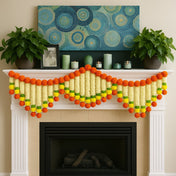Have you ever noticed how the gentle chime of a brass bell instantly evokes a sense of reverence and spirituality? Across cultures and religious traditions, brass bells have long served as powerful symbols of divine connection and spiritual awakening.
For thousands of years, these sacred instruments have resonated in temples, churches, and spiritual gatherings. From the deep, resonant tolls of Hindu temple bells to the melodic chimes of Christian church bells, each ring carries profound cultural and spiritual significance.
Brass bells are often seen as bridges between the earthly and the divine, with their distinct sounds believed to:
- Dispel negative energies
- Mark sacred moments
- Call worshippers to prayer
- Enhance spiritual awareness
Join us on a journey to explore the rich history, intricate craftsmanship, and deep spiritual meaning of brass bells. We’ll uncover how these timeless instruments continue to shape religious ceremonies and cultural traditions worldwide, as well as their role in various celebrations across different cultures. For instance, during Diwali, the festival of lights in India, brass bells play a significant role in rituals and prayers.
Moreover, gifting during such celebrations holds a special importance. We will share some unique gifting ideas that can make your celebrations even more memorable.
In addition to that, we will also discuss how certain items like 100% cotton sheets or personalized Diwali gift hampers can add a personal touch to your festivities.
Lastly, we will explore how traditional customs like Rakhi, a festival celebrating sibling bonds in India, often involve unique rituals that further enhance our understanding of these cultural practices.
Historical Significance of Brass Bells
The mesmerizing sound of brass bells has echoed through human civilization for thousands of years. Archaeological evidence reveals their use in ancient Assyria and Babylon as early as 3000 BCE, serving both practical and ceremonial purposes.
Ancient Uses of Brass Bells
Early civilizations crafted these melodious instruments with remarkable precision:
- Mesopotamian Temples housed large brass bells, believed to ward off evil spirits.
- Egyptian Tombs contained small brass bells, used as protective amulets for the deceased.
- Greek Sanctuaries rang bells to announce sacred ceremonies.
- Iranian Temples incorporated bells into fire worship rituals.
- Indian Shrines featured bells of various sizes for different religious ceremonies.
The Evolution of Brass Bell Craftsmanship
The craftsmanship of brass bells evolved alongside technological advancements. While early bells were simple cast metal objects, artisans later developed intricate techniques to produce refined tones and elaborate designs. In India, the ghanta emerged as a distinctive bell style, known for its rich harmonics and detailed engravings.
Spiritual Beliefs Surrounding Brass Bells
Ancient cultures attributed unique properties to brass bells:
"The metal’s resonance could bridge the earthly and divine realms." — Ancient Sanskrit Text
This belief led to the integration of brass bells in:
- Religious ceremonies
- Royal court gatherings
- Military signals
- Agricultural rituals
- Trade announcements
Cultural Significance of Brass Bells
Despite the rise and fall of civilizations, brass bells have maintained their significance across cultures. Their enduring presence in religious and spiritual practices highlights their symbolic power and their role in creating sacred atmospheres.
Interestingly, while brass bells have been a significant part of Indian culture, other items like silver toe rings and nose rings also hold cultural significance. Silver toe rings, with their alluring shimmer, have transcended time and cultural boundaries. Similarly, nose rings adorned with rhodium plating are often gifted during Indian weddings.
Moreover, the craftsmanship seen in items like Indian bracelet boxes, showcases the vibrant culture and artistry of India. The use of Ganesha print jute bags during pooja or religious rituals further emphasizes the integration of various crafts into daily life.
In addition to these items, certain accessories like the mindhol rumal are used in specific rituals during Indian weddings, highlighting the diverse cultural practices in India.
Craftsmanship of Brass Bells
The creation of brass bells begins with a carefully measured blend of 70% copper and 30% zinc, forming a resonant alloy that produces their signature rich tone. Master craftsmen have refined this precise combination over generations, passing down their expertise through apprenticeships.
Traditional Handcrafting Process
- Metal Preparation – Raw copper and zinc are melted in traditional furnaces at temperatures exceeding 1,800°F.
- Molding – The molten brass is poured into meticulously crafted sand molds or clay casts.
- Cooling and Shaping – Each bell undergoes controlled cooling to prevent cracks and ensure structural integrity.
- Tuning – Skilled artisans carefully file and hammer specific areas to achieve the perfect pitch.
- Surface Treatment – Traditional polishing techniques enhance the bell’s natural luster.
Crafting a brass bell demands exceptional skill at every stage. Artisans must possess deep knowledge of metal properties, sound dynamics, and the patience to refine each piece to perfection. A single handcrafted bell can take several days to complete, reflecting the dedication and artistry behind its creation.
Machine-Made vs. Handcrafted Bells
|
Aspect |
Handcrafted Brass Bells |
Machine-made Brass Bells |
|
Sound Quality |
Rich, complex overtones with unique sonic signatures |
Consistent but less nuanced sound profiles |
|
Aesthetic Characteristics |
Subtle variations in texture, natural patina development |
Uniform appearance, standardized finish |
|
Durability |
Thicker walls, stronger joints |
Precise but potentially thinner construction |
The beauty of handcrafted brass bells lies in their uniqueness. Each bell bears the artisan's touch—subtle variations in thickness, delicate hammer marks, and distinctive tonal qualities that mass production cannot replicate. These imperfections add character, making every bell not just a musical instrument but a true work of art, each with its own story woven through craftsmanship.
Interestingly, the skills used in crafting brass bells are similar to those employed in creating other handmade items such as wooden printing stamps used for crafting hand-carved Indian textiles. Just like the intricate designs on these stamps require a deep understanding of material properties and a high level of craftsmanship, so does the process of making brass bells.
Moreover, handcrafted items such as hammered copper plating dryfruits jars also share this artisan quality. Each jar tells a story through its unique design and craftsmanship.
In addition to bells, there are other traditional items like brass oil diyas used during religious ceremonies that showcase similar craftsmanship. These diyas not only serve a functional purpose but also add aesthetic value to the space they occupy.
Finally, the artistry involved in crafting items like banana leaf backdrops used for pooja ceremonies is yet another example of skilled craftsmanship that weaves culture into every piece created.
Symbolism in Various Religions
The melodic chime of brass bells fills sacred spaces across various faiths, each ring carrying deep spiritual significance. These metallic messengers serve as a bridge between the earthly and divine, uniting worshippers with the sacred.
Brass Bells in Hinduism
In Hindu temples, brass bells (ghanta) serve as divine awakeners, rung by devotees before entering the inner sanctum to signal their arrival to the deities. Their resonant sound is believed to create auspicious vibrations that dispel negative energy, fostering a sacred and purified space.
The act of ringing the bell also helps center the mind, enhancing focus and devotion during worship while symbolically bridging the physical and spiritual realms.
During aarti (worship rituals), the rhythmic chimes of the bell harmonize with the chanting of mantras, cultivating an atmosphere of reverence and deepening the spiritual connection between devotees and the divine. This is similar to the spiritual ambiance created by gold plated idols that are often used in Hindu worship.
Buddhism
Buddhist traditions incorporate brass bells (ghanta) as tools for:
- Marking the beginning and end of meditation
- Representing wisdom and compassion
- Creating mindfulness through sound
- Awakening sentient beings to enlightenment
The pure, clear tone of Buddhist bells serves as a reminder of the Buddha's voice, calling practitioners to mindfulness and presence. Such mindfulness can also be achieved through practices using meditation singing bowls, which are known for their stress healing properties.
Christianity
Church bells hold multiple layers of meaning in Christian traditions:
- Calling worshippers to prayer
- Marking significant life events (weddings, funerals)
- Announcing times of celebration or mourning
- Symbolizing God's voice reaching out to the community
Zoroastrianism
In Zoroastrian ceremonies, brass bells serve as:
- Instruments of purification
- Tools for dispelling negative energies
- Symbols of divine protection
- Markers of ritual transitions
Chinese Traditions
Ancient Chinese temples feature elaborate bell systems that:
- Mark the hours of prayer and meditation
- Ward off evil spirits
- Bring good fortune
- Create harmony between heaven and earth
The distinctive tones of brass bells in Chinese temples are carefully crafted to produce specific frequencies believed to resonate with cosmic energies.
Spiritual Significance and Effects of Brass Bells
The resonating tones of brass bells extend far beyond their physical sound, creating powerful vibrations that influence both space and well-being. These sound waves, measured between 432 Hz and 442 Hz, align with the Earth's natural frequency—often referred to as the "Om" frequency—which explains why many experience a profound sense of harmony when hearing them.
Spiritual and Energetic Benefits
- Energy Cleansing – The vibrations from brass bells are believed to dissolve negative energy, making way for positivity.
- Mental Clarity – Regular exposure to their sound can help quiet the mind, promoting deeper states of meditation.
- Spatial Purification – The sound waves penetrate even the most hidden spaces, acting as a sonic purifier beyond physical cleaning.
The Science Behind Their Resonance
"The combination of copper and zinc in brass creates a distinctive resonance that generates both audible sound and subtle energy frequencies, influencing human biorhythms." – Ancient Sound Healing Principles
Traditional Bell-Ringing Practices
- Morning Purification – Ring 7 times to activate positive energy.
- Space Clearing – Ring 21 times in a counterclockwise direction to dispel stagnant energy.
- Mental Balance – Ring 11 times while focusing on a specific intention.
Ancient texts describe brass bells as gateways between the physical and spiritual realms. Their chimes are believed to form a protective barrier against negativity while amplifying uplifting vibrations in the surrounding environment.
Beyond spiritual benefits, the healing properties of brass bells also support physical well-being—many practitioners report improved sleep, reduced stress, and enhanced focus after regular exposure to these sacred sounds.
Incorporating brass items like this peacock deepam brass finish diya into your space can further enhance these benefits. This traditional oil lamp not only serves as a beautiful piece of decor but also contributes to the overall spiritual ambiance by radiating positive energy during rituals or festivals.

Cultural Contexts and Practical Uses of Brass Bells
Brass bells extend far beyond their religious significance, enriching our daily lives in unexpected ways. Let's explore their diverse applications in modern contexts.
1. Home Decor
Brass bells transform living spaces into sanctuaries of peace and beauty. Here's how homeowners incorporate these timeless pieces:
Entryway Enhancement: Hanging brass bells near doorways creates a welcoming atmosphere while serving as conversation starters. Consider pairing them with decorative antique dancing lady door pull handles for a unique touch.
Garden Aesthetics: Wind-activated bells add musical elements to outdoor spaces, creating natural wind chimes. Adding some artificial marigold flowers jumbo jhoomar can complement the aesthetic beautifully.
Interior Accents: Decorative bell clusters bring warmth to living rooms, meditation spaces, or reading nooks.
2. Community Celebrations
Brass bells play vital roles in bringing people together:
Cultural Festivals: Communities ring bells in unison during harvest celebrations and seasonal gatherings.
Wedding Ceremonies: Traditional bell-ringing marks significant moments in marriage celebrations across cultures. These moments can be enhanced with beautiful backdrops like the elephant ganesh backdrop or the radha krishna with peacock backdrop.
Public Events: Large brass bells announce the start of community gatherings, markets, and local festivities.
3. Modern Applications
Creative uses of brass bells in contemporary settings include:
- Sound therapy sessions in wellness centers
- Mindfulness practice tools in yoga studios
- Artistic installations in public spaces
- Time markers in educational institutions
The adaptability of brass bells makes them a cherished addition to both personal sanctuaries and communal gatherings. Their presence elevates everyday moments into profound experiences, fostering a deep connection between individuals and their surroundings through sound and symbolism.
Conclusion
Brass bells have long symbolized humanity’s deep desire to connect with the divine, their resonant chimes echoing through temples, churches, and sacred spaces for thousands of years. More than just instruments, they create a bridge between the physical and spiritual realms, carrying prayers and intentions skyward.
Beyond their spiritual role, brass bells bring people together in shared experiences, uniting communities through their rhythmic calls to worship. Their intricate craftsmanship reflects the artistry of skilled metalworkers, while their presence in rituals and traditions preserves cultural heritage for future generations.
Whether adorning a temple doorway, gracing a home’s entrance, or marking time in a village square, these timeless objects hold a significance that extends far beyond their form. They serve as reminders of our innate need for spiritual connection, their sacred sounds resonating across faiths and traditions, speaking a universal language of devotion and reverence.
As we celebrate festivals like Navratri or Diwali, the gentle chime of a brass bell calls us to pause, reflect, and remember our connection to the divine - a testament to their lasting significance in human spiritual expression.




















